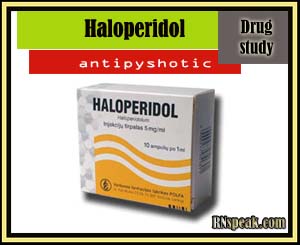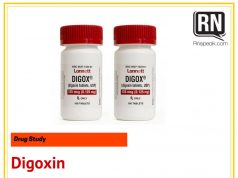 Generic Name: Haloperidol,Haloperidol Decanoate
Generic Name: Haloperidol,Haloperidol Decanoate
Brand Name:Haldol, Peridol,
Classifications:central nervous system agent; psychotherapeutic; antipsychotic; butyrophenone
Pregnancy Category:C
Availability
0.5 mg, 1 mg, 2 mg, 5 mg, 10 mg, 20 mg tablets; 2 mg/mL oral solution; 5 mg/mL, 50 mg/mL, 100 mg/mL injection
Actions
Potent, long-acting butyrophenone derivative with pharmacologic actions similar to those of piperazine phenothiazines but with higher incidence of extrapyramidal effects and less hypotensive and relatively low sedative activity.
Therapeutic effects
Decreases psychotic manifestations and exerts strong antiemetic effect.
Uses
Management of manifestations of psychotic disorders and for control of tics and vocal utterances of Gilles de la Tourette’s syndrome; for treatment of agitated states in acute and chronic psychoses. Used for short-term treatment of hyperactive children and for severe behavior problems in children of combative, explosive hyperexcitability.
Unlabeled uses
Cancer chemotherapy as an antiemetic in doses smaller than those required for antipsychotic effects; treatment of autism; alcohol dependence; chorea.
Contraindications
Parkinson’s disease, parkinsonism, seizure disorders, coma; alcoholism; severe mental depression, CNS depression; thyrotoxicosis. Safe use during pregnancy (category C), lactation, or in children <3 y is not established.
Cautious use
Older adult or debilitated patients, urinary retention, glaucoma, severe cardiovascular disorders; patients receiving anticonvulsant, anticoagulant, or lithium therapy.
Route& Dosage
Psychosis
adult:PO 0.2–5 mg b.i.d. or t.i.d.
IM 2–5 mg repeated q4h prn; Ddecanoate 50–100 mg q4wk
child:PO 0.5 mg/d in 2–3 divided doses, may be increased by 0.5 mg q5–7d to 0.05–0.15 mg/kg/d
Severe Psychosis
adult: PO 3–5 mg b.i.d. or t.i.d., may need up to 100 mg/d
IM 2–5 mg, may repeat q.h. prn, Decanoate: 50–100 mg q4wk
child:PO 0.05–0.15 mg/kg/d in 2–3 divided doses
Dementia
geriatric: PO 0.25–0.5 mg 1–2 times daily, may increase every 4–7 d (max: 4 mg/d in 2–3 divided doses)
Tourette’s Disorder
adult: PO 0.2–5 mg b.i.d. or t.i.d.
child: PO 0.05–0.075 mg/kg/d in 2–3 divided doses
Administration
Oral
- Give with a full glass (240 mL) of water or with food or milk.
- Taper dosing regimen when discontinuing therapy. Abrupt termination can initiate extrapyramidal symptoms.
Intramuscular
- Give by deep injection into a large muscle. Do not exceed 3 mL per injection site.
- Have patient recumbent at time of parenteral administration and for about 1 h after injection. Assess for orthostatic hypotension.
- Store in light-resistant container at 15°–30° C (59°–86° F), unless otherwise specified by manufacturer. Discard darkened solutions.
Adverse effects
CNS:Extrapyramidal reactions: Parkinsonian symptoms, dystonia, akathisia, tardive dyskinesia (after long-term use); insomnia, restlessness, anxiety, euphoria, agitation, drowsiness, mental depression, lethargy, fatigue, weakness, tremor, ataxia, headache, confusion, vertigo; neuroleptic malignant syndrome, hyperthermia, grand mal seizures, exacerbation of psychotic symptoms.
CV:Tachycardia, ECG changes, hypotension, hypertension (with overdosage).
Endocrine:Menstrual irregularities, galactorrhea, lactation, gynecomastia, impotence, increased libido, hyponatremia, hyperglycemia, hypoglycemia.
SpecSenses:Blurred vision.
Hematologic:Mild transient leukopenia, agranulocytosis (rare).
GI:Dry mouth, anorexia, nausea, vomiting, constipation, diarrhea, hypersalivation.
Urogenital:Urinary retention, priapism.
Respiratory:Laryngospasm, bronchospasm, increased depth of respiration, bronchopneumonia, respiratory depression.
Skin:Diaphoresis, maculopapular and acneiform rash, photosensitivity.
other:Cholestatic jaundice, variations in liver function tests, decreased serum cholesterol.
Interaction
drug:cns depressants,opiatesalcohol increase CNS depression; may antagonize activity of oral anticoagulants; anticholinergics may increase intraocular pressure; methyldopa may precipitate dementia.
Nursing implications
Assessment & Drug Effects
- Monitor for therapeutic effectiveness. Because of long half-life, therapeutic effects are slow to develop in early therapy or when established dosing regimen is changed. “Therapeutic window” effect (point at which increased dose or concentration actually decreases therapeutic response) may occur after long period of high doses. Close observation is imperative when doses are changed.
- Target symptoms expected to decrease with successful haloperidol treatment include hallucinations, insomnia, hostility, agitation, and delusions.
- Monitor patient’s mental status daily.
- Monitor for neuroleptic malignant syndrome (NMS) , especially in those with hypertension or taking lithium. Symptoms of NMS can appear suddenly after initiation of therapy or after months or years of taking neuroleptic (antipsychotic) medication. Immediately discontinue drug if NMS suspected.Monitor for parkinsonism and tardive dyskinesia . Risk of tardive dyskinesia appears to be greater in women receiving high doses and in older adults. It can occur after long-term therapy and even after therapy is discontinued.
- Monitor for extrapyramidal (neuromuscular) reactions that occur frequently during first few days of treatment. Symptoms are usually dose related and are controlled by dosage reduction or concomitant administration of antiparkinson drugs.
- Be alert for behavioral changes in patients who are concurrently receiving antiparkinson drugs.
- Monitor for exacerbation of seizure activity.
- Observe patients closely for rapid mood shift to depression when haloperidol is used to control mania or cyclic disorders. Depression may represent a drug adverse effect or reversion from a manic state.
- Lab tests: Monitor WBC count with differential and liver function in patients on prolonged therapy.
Patient & Family Education
- Avoid use of alcohol during therapy.
- Do not drive or engage in other potentially hazardous activities until response to drug is known.
- Discuss oral hygiene with health care provider; dry mouth may promote dental problems. Drink adequate fluids.
- Avoid overexposure to sun or sunlamp and use a sunscreen; drug can cause a photosensitivity reaction.
- Do not breast feed while taking this drug without consulting physician.







